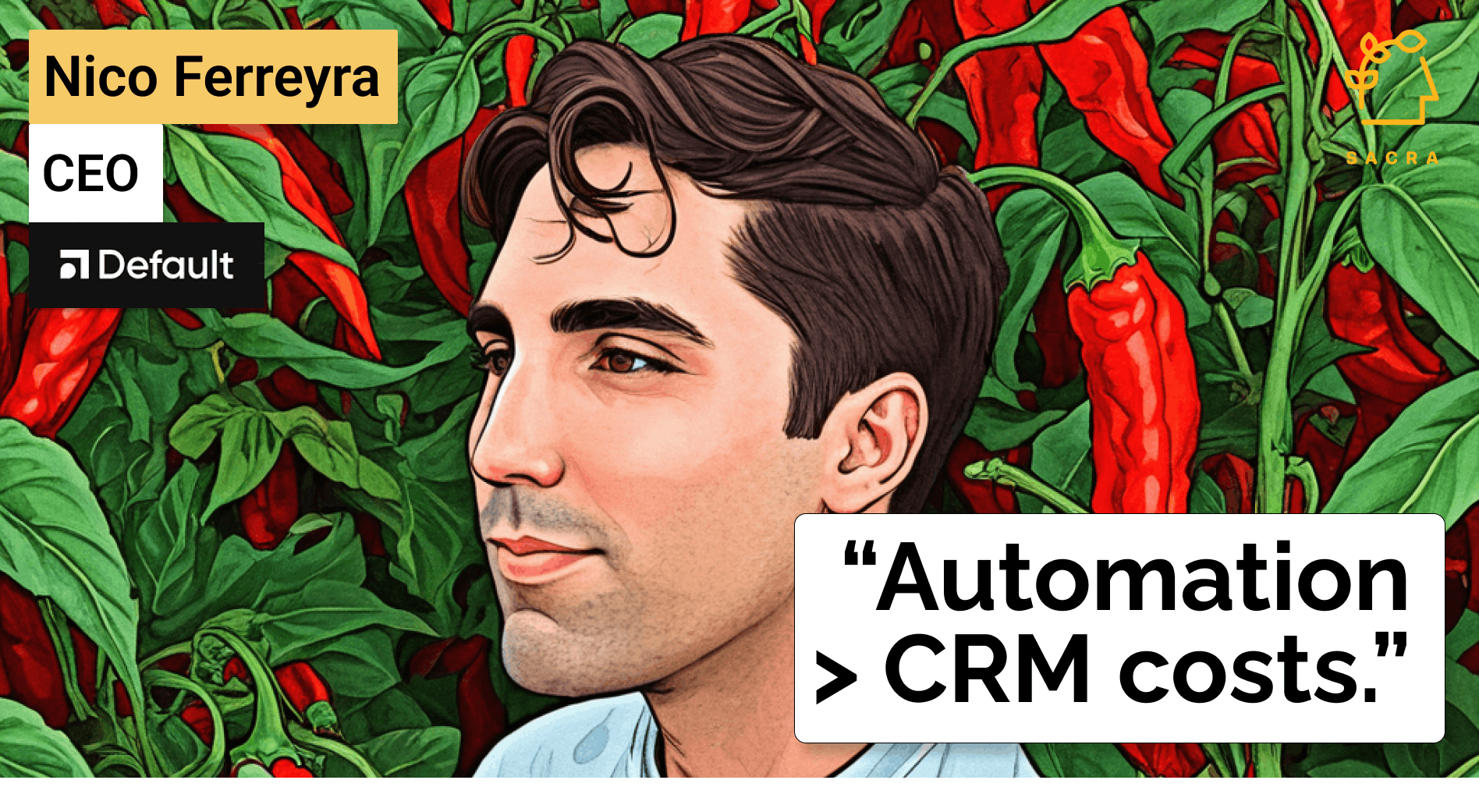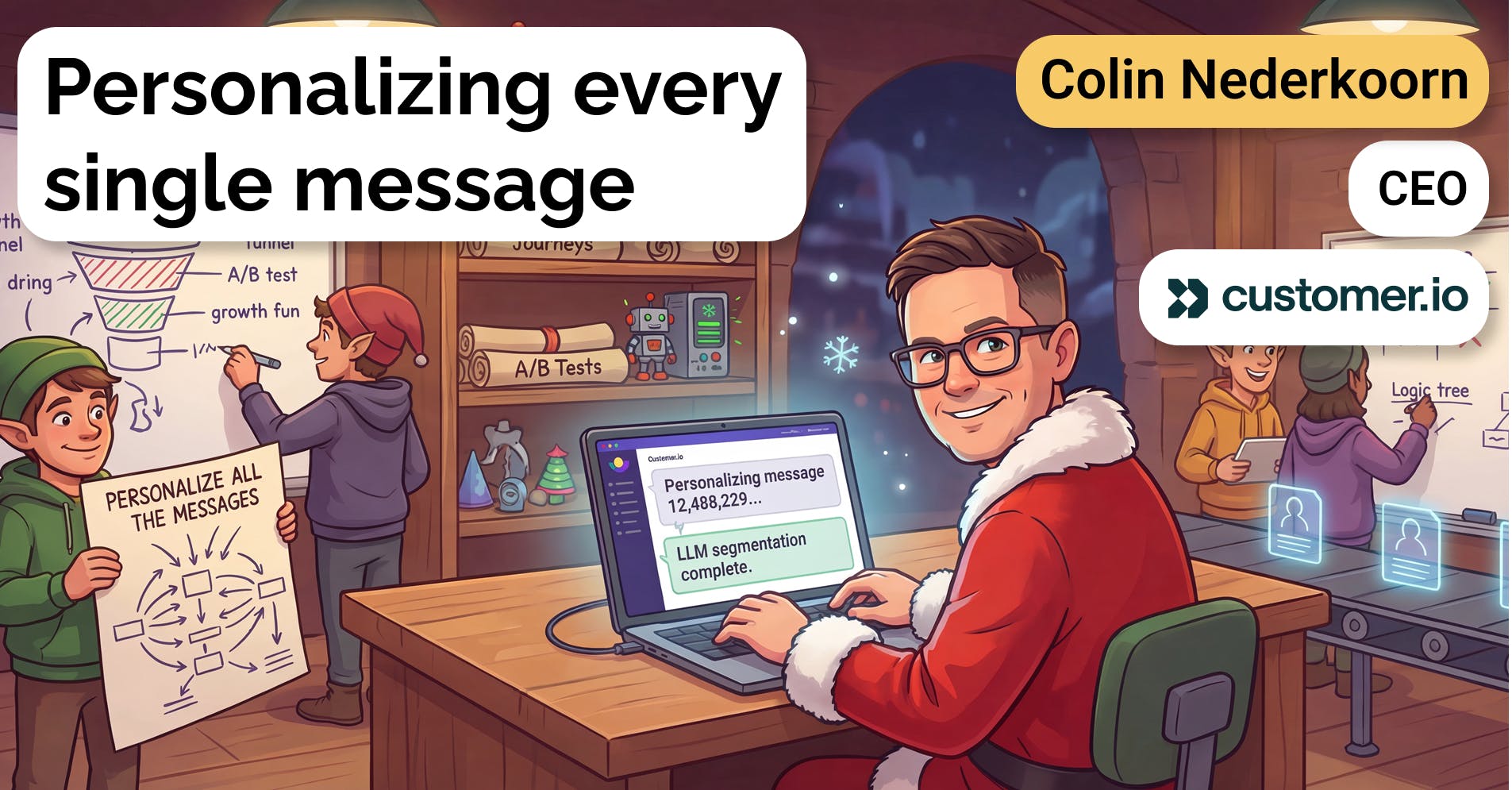Nico Ferreyra, CEO of Default, on building an end-to-end inbound sales platform
 Jan-Erik Asplund
Jan-Erik Asplund

Background
When we spoke with Austin Hughes, co-founder & CEO at Unify, he called out Default as part of a new AI-native next-gen sales stack. We reached out to Nico Ferrerya, co-founder & CEO at Default, to learn how Default is building on lead routing products like Chili Piper (Base10 Partners, $54M raised).
Key points from our conversation via Sacra AI:
- Pure product-led growth is giving way to a hybrid of self-serve plus inbound sales, requiring go-to-market teams to create forms (Typeform), enrich new leads (Clearbit), qualify them (HubSpot), route & schedule meetings (Calendly), and start email sequences (Outreach), with Zapier to stitch it all together. “We also had to build a lot of custom tooling, specifically dashboards to track attribution… What we discovered was that we were actually spending more on general-purpose automation tooling, custom development, and enrichment than on our CRM and everything else combined. Automation and data became the true cost center, wrapped in other SaaS expenditures.”
- As budget for all these tools for automation has begun to exceed the cost of CRM itself, companies like Default (Craft Ventures, $11.3M raised), Calendly ($270M ARR), and Clay (Sequoia, $62M raised) have begun bundling scheduling with lead capture, enrichment, qualification, and routing into a unified revenue ops dashboard. “At the end of the day, it's really about which system owns the most mission-critical business logic: who owns the territories, who owns the segments, who owns the global user ID of the sales rep across the organization… That's what allows us to command the end game for the workflows that we seek to automate first.”
- To ensure that prospect behavior, sales team behavior and qualification criteria exists on their platform and avoid getting frontrun, incumbents Clari (Sequoia, $496M raised), Gong ($285M ARR), and ZoomInfo (NASDAQ: ZI) will build or buy to bring this data and these workflows into their all-in-ones. “If you're an incumbent like Clari, Gong, or ZoomInfo, building or buying your way towards being an all-in-one platform isn't really the hard part. The challenge is actually getting your customers to use and pay for all or most of your SKUs and not turn them off… I might be wrong, but I think in the next 3 to 4 years, we're going to see a lot of the same solutions, either through hardcore R&D like ZoomInfo is doing or aggressive M&A like Clari's approach.”
Questions
- What is Default and what inspired you to start the company?
- I had a question about the pre-Default and post-Default experience and automation. You've hinted at this stack of Typeform, Zapier, Customer.io, and Clearbit. You also mentioned another stack: HubSpot Forms, Chili Piper, LeanData, and Salesforce. Can you map out that evolution for me?
- What does your early product-market fit look like? How did you find your first customers? Who is your core customer, who buys and uses Default inside the org and how do they use Default?
- Chili Piper (2016) was the first big player in the lead qualification/routing space. How do you position Default with respect to Chili Piper?
- Can you elaborate on the time delay synchronization issue you mentioned?
- You mentioned lead routing as a wedge into building the next sales and marketing cloud. I'm curious about how you think about sequencing on a product R&D level. Do you start with this moment of ingestion? Do you have a sense of how you sequence the rest of your journey?
- How do you position vs general purpose tools like Calendly and Zapier that are used across the org already?
- What tools do your customers use together with Default and what does a modern go-to-market stack look like?
- A huge amount of bundling is taking place in the rev ops / go-to-market stack. Call recording (Gong) is becoming part of every tool. Same with contact data (Apollo.io), predictive analytics (Clari) and more. Is the trend towards all-in-one and if so, how do you think about which platforms have the best potential to transition from point solutions to all-in-one?
- Sales productivity and minimizing sales headcount is a major trend. Is that a tailwind for Default? How do your customers think about driving productivity of individual reps and driving more revenue per rep so as not to have to scale headcount linearly?
- Enrichment is an area where AI should be driving much higher data quality and specificity at scale. Clay is a company that comes up a lot in the context of the modern sales stack. Is improving data enrichment a tailwind for Default? How do you think about it?
- Default uses AI for use cases like composing follow-up and thank-you emails for prospects. To what extent do you think about AI as a foundational tech for what you’re building and how important is it to your vision?
- What do you think about what you’re seeing with the evolution of AI in the sales stack overall?
- With data on lead qualification, routing, and attribution across many B2B companies, you have a unique view into what's working in go-to-market. What does this kind of data position you to build for customers in the future?
- If everything goes right for Default over the next 5 years, what will it become and how is the world changed?
- Default positions itself as an all-in-one. What do you see as the boundaries of where that all-in-one extends and what the breakpoints are?
Interview
What is Default and what inspired you to start the company?
At Default, we're building a new go-to-market platform designed to help B2B companies grow better, faster, and cheaper, starting with their inbound lead funnel. When we first started thinking about launching a company in this space in late 2021, we saw three opportunities emerging.
1. The revenue intelligence space, with companies like Gong, Clari, and ZoomInfo converging to offer cohesive, bundled solutions that incorporate first-party data from email activity, call recording insights, forecasting, and more.
2. The CPQ (Configure, Price, Quote) and order forms space, where various companies are approaching the opportunity from different angles.
3. The inbound marketing stack, which includes scheduling, forms, routing, enrichment, and generic workflow automation.
We felt we were best suited to address the inbound side, which really piqued our interest. At our previous company, we had stitched together various tools like Typeform, Calendly, Zapier, early Clearbit, HubSpot, and Customer.io. We also had to build a lot of custom tooling, specifically dashboards to track attribution, as we were a small team of 3-4 people trying to automate as much as possible in our go-to-market efforts.
What we discovered was that we were actually spending more on general-purpose automation tooling, custom development, and enrichment than on our CRM and everything else combined. Automation and data became the true cost center, wrapped in other SaaS expenditures. This was just for a small team, and you can imagine how these costs would balloon as the company grew.
We started in 2021 and spent about 18 months building out a bundled solution for what we call the "super fan" of the market. When you take a bundle to market, you typically have two audiences: the super-fan and the casual market participant.
The casual participant may buy out of convenience but isn't willing to pay a premium for the bundle. Our super fan is usually a very disgruntled RevOps, marketing ops, marketing, or sales leader who is so unhappy with the status quo of using a hodgepodge of tools (like HubSpot forms, Chili Piper, and Salesforce automations) that they're willing to consolidate the entire process end-to-end and pay a slight premium for it.
We started there, and as we attract more of these super fans, we're working to make the product generally available for companies of all sizes.
I had a question about the pre-Default and post-Default experience and automation. You've hinted at this stack of Typeform, Zapier, Customer.io, and Clearbit. You also mentioned another stack: HubSpot Forms, Chili Piper, LeanData, and Salesforce. Can you map out that evolution for me?
One of the early bets we made was on the increasing complexity of the go-to-market stack and processes. This complexity has arisen with the rebranding of freemium as product-led growth (PLG) and the introduction of many tools adding significant functionality. For example, Webflow and Framer are adding forms, while Calendly is adding routing.
We realized that to build a really big company in this space of the business stack, you would need to invest heavily in integration. What we're seeing now is smaller companies starting not with a marketing automation platform, as they might have 4 or 5 years ago, but with a content management system (CMS) like Webflow. They then need to connect that CMS to their sales stack, including the underlying sales and marketing workflow for inbound lead qualification, routing, scheduling, and so on.
To address this, we had to invest significantly in our product to make it compatible with the various tech stacks we encounter. This approach allows us to accommodate the diversity we see in how companies are structuring their marketing and sales technologies.
What does your early product-market fit look like? How did you find your first customers? Who is your core customer, who buys and uses Default inside the org and how do they use Default?
Our first customers primarily came through two channels: inbound and outbound. Inbound customers found us through LinkedIn posts or our early blog posts. They reached out and booked a demo with our software, already knowing what their inbound solution could feel like from the end-to-end experience, including the sequence we sent immediately after they booked a meeting or if they abandoned the scheduler. For outbound, I personally reached out to quite a few folks early on, which is how we initially booked meetings.
Currently, we've shifted to being primarily inbound-focused, with about 90% of our customers coming through that channel. The main systems we've been replacing, where the value is really significant for us, are typical point solutions like Chili Piper, Calendly, and LeanData.
The people who typically find us are marketing leaders such as VP of Demand Gen, VP of Marketing, or Head of Marketing, usually from Series A to Series C stage companies, sometimes a bit earlier. They're typically replacing standard off-the-shelf point solutions.
What typically happens is they come to us with one job to be done. They're spending a lot of money on ads or getting significant inbound traffic because their content machine or word-of-mouth is working well. In some way, they've created gravity in the market, and customers are coming to them. They need some sort of stop-loss mechanism to ensure that the generated pipeline doesn't go to waste.
Often, they realize that the workflow they've diagrammed out in tools like Miro, Lucidchart, or FigJam doesn't really fit the capabilities of their tech stack. Default was essentially built around the diagrams we saw early on from customers telling us, "This is how we qualify, this is how we want our inbound solution to work, and our biggest challenge is trying to map this process into 3 or 4 different tools."
Typically, they'll come in and automate one or two jobs to be done, such as inbound lead qualification, scheduling, routing, enrichment, and CRM ops. The technical buyer or champion for us is usually RevOps or the technical go-to-market generalist on the team. They'll automate one process and then realize there's a lot more they can do with Default. This might include enriching new CRM objects, performing scheduled enrichment, or handling lead routing when the marketing team uploads a CSV of leads to Default.
Instead of routing via Salesforce flows, they've already got all their routing territory, segment, and user group logic built in Default. So they often decide to migrate the source of leads into Default and let it handle the rest of the process.
Chili Piper (2016) was the first big player in the lead qualification/routing space. How do you position Default with respect to Chili Piper?
We don't really think of ourselves as Chili Piper 2.0 or a better Chili Piper. What we really found was that there's a sort of door in the market that the customer sees, which is the primary job to be done: booking meetings and routing leads from their web forms, CRM triggers, and CSV list uploads.
We think that's an incredible wedge to build the next sales and marketing cloud because two things are happening. First, you're forced to build a comprehensive integration suite because you're sitting at the point of ingestion for this first-party data. You have to be able to read and write to virtually every system in the stack in the right format. At the same time, you're also collecting that data. You're mapping first name, last name from a form into default, and default passes that as first name, last name into Slack and Outreach, etc.
There are these two races that you have to run. One is actually building the underlying platform and defining this really fleshed-out first-party data model. The second is playing Switzerland of the stack, not really stepping on any toes except for scheduling and routing, but you're writing to everything downstream.
For us, we see the inbound scheduling and inbound routing as the lowest NPS category, where it's very easy for us to go in, accrue a lot of stickiness, and gain platform power. As we continue to invest in product and R&D, we'll eventually come out with something that is a much more comprehensive solution.
Can you elaborate on the time delay synchronization issue you mentioned?
For sure, if you think about routing, a lot of that is defined in the CRM. You have the territory object, user groups, etc. There’s an issue with speed-to-lead with this setup for a lot of companies.
Take a company that uses Marketo forms to collect leads on their website. That form submission lands in Marketo, where some deduplication happens on the lead and email address. There's about a 5-minute time delay before that data hits Salesforce - it's just a Marketo thing. So you're not actually able to do real-time routing or assignment as soon as someone has submitted that form on the website.
You have to wait at least 5 minutes for it to hit Salesforce, and then have some Salesforce automation that runs and distributes that lead to the right rep, probably hooking up to something like Chatter or Slack to notify the rep that a lead has been assigned. Then that rep has to go in and usually they're just hitting "Add to Outreach" in their Salesforce leads list, and then reaching out with a booking link. There's this whole other set of problems around SLAs and rules of engagement that many larger sales teams have to define.
What you're able to do is have a system that can read things like CRM ownership. This means finding if a matching record already exists. For example, if this is a closed-lost opportunity from last quarter and we want to make sure that this prospect has the best experience possible, we have the highest likelihood of closing them as a customer. We ensure they get to the right rep and the right SDR. If there's an open opportunity, we make sure it gets routed to either the AE on that opportunity, the AE on the account, or the SDR on the opportunity if it's in a different opportunity stage.
You can't really do that with a traditional marketing automation platform setup. That's where our ability to read real-time ownership, territory, and segment comes in. You can define these in default objects, but it's primarily around ownership and other CRM data.
You mentioned lead routing as a wedge into building the next sales and marketing cloud. I'm curious about how you think about sequencing on a product R&D level. Do you start with this moment of ingestion? Do you have a sense of how you sequence the rest of your journey?
Currently, our high-level SKUs are forms, scheduling, workflows, and our pipeline product, which is essentially a lightweight CRM for inbound. Our workflows product is an incredible way for us to determine what to build next. I should also mention that on the scheduling side, we own the meeting object because we're creating the meeting and people are interacting with it via Default. We also have leads and companies on the pipeline side, so we've got some underlying objects there.
The way we build a really big company over the next 10 years is by winning customers early on in their lifecycle and ensuring they stick with us. We need to increase the switching costs as companies grow, and the byproduct of that is building out a highly cross-sellable suite of SKUs. Being able to engage with people in real-time is crucial. For us, knowing what's actually happening in customers' go-to-market engines is a huge unlock to be able to do that.
Our workflows product essentially uses Default as a source and writes to multiple destinations. It's kind of like a take on how Segment might be built for the modern sales stack. If we know that all of our customers are writing to Outreach, we know there's probably a world where we build a sequencer.
If people are adding Gong or Wingman to meetings within Default as an automation, we know we should probably support call recording as well. There's a myriad of other smaller add-ons, like Salesforce marketplace add-ons and HubSpot apps, that we will start chipping away at as our initial workflow canvas gets better. In short, we use our product and customer setups to inform what we build next.
How do you position vs general purpose tools like Calendly and Zapier that are used across the org already?
Definitely. I don't think we've ever lost a deal to Calendly or Zapier. They're almost always there, but the form factor for this company that we have in mind is something I think those two companies would have a very hard time evolving into, just because it's so domain-model specific. They weren't really built for revenue teams initially.
I think Zapier has built greater and greater depth into their integrations to support these one-off use cases that are a huge pain for RevOps teams, especially having to stitch this stuff together. But at the end of the day, it's really about which system owns the most mission-critical business logic: who owns the territories, who owns the segments, who owns the global user ID of the sales rep across the organization.
Default maps to the user ID for the rep across all these different tools, and that user ID maps to the territory segment user group object within Default. That's what allows us to command the end game for the workflows that we seek to automate first.
We are very impartial to whether or not you use Calendly or Zapier. We know that for you to get the most value out of Default, you're going to use our first-party scheduling. Zapier is a great product and it's definitely here to stay, but there are multiple situations where we're co-deployed with Calendly and Zapier across organizations.
What tools do your customers use together with Default and what does a modern go-to-market stack look like?
Our happiest customers definitely have a ton of sales tools, and the value we bring to them is integration of all these tools across one workflow.
You can think of a CRM like Salesforce - if a customer has Salesforce and they have Outreach or Salesloft, and they have Gong, and they're using something like Clay or Zapier or any of these other new age outbound solutions as well, they're probably going to be a very good and very happy Default customer.
At the end of the day, we're solving deeply-ingrained integration problems for this workflow. We definitely see Clay a lot, we see Apollo a lot, and increasingly Smartlead and Instantly even in much larger companies. Those are kind of the biggest ones we see for outbound.
A huge amount of bundling is taking place in the rev ops / go-to-market stack. Call recording (Gong) is becoming part of every tool. Same with contact data (Apollo.io), predictive analytics (Clari) and more. Is the trend towards all-in-one and if so, how do you think about which platforms have the best potential to transition from point solutions to all-in-one?
I think that if you're an incumbent like Clari, Gong, or ZoomInfo, building or buying your way towards being an all-in-one platform isn't really the hard part. The challenge is actually getting your customers to use and pay for all or most of your SKUs and not turn them off. Most of the money is in expansion, and there are a couple of different arguments to be made and approaches to take.
If you're Clari or Gong, you really have to worry about overcoming the very high switching costs that a competitor like Gong may already have at one of the companies in the segment you're both selling to. Outreach and Clari might be selling to the same type of company with similar solutions, and I think there are two paths to address this:
First, as an enterprise incumbent who often sees the CFO and CRO in deals, you have to be really good at product development or M&A. Clari and Gong are two strong contenders here, as well as ZoomInfo. The challenge is that there's a bit of a race to the bottom on pricing, and the profit may get squeezed out of the category long-term.
I might be wrong, but I think in the next 3 to 4 years, we're going to see a lot of the same solutions, either through hardcore R&D like ZoomInfo is doing or aggressive M&A like Clari's approach. Clari bought Wingman, recently acquired Groove, and is taking more of a Salesforce approach to becoming a comprehensive platform.
The other approach is to start with companies when they're under 30 people and grow with them, cross-selling new products and incrementally increasing the switching costs every couple of quarters. For example, when a company hits 3 reps or seats, you give them call recording at a 30% discount compared to the à la carte, best-of-breed solution in the market. You'd be happy with 140% net revenue retention, but you'd probably hit a wall in terms of the size of companies you can target, likely around 200 to 300 employees, similar to Rippling.
If you've started by building for the mid-market with deeper, harder integration problems, then you can probably sell both the platform and à la carte solutions. It's just a more challenging go-to-market motion, which is more our style.
Sales productivity and minimizing sales headcount is a major trend. Is that a tailwind for Default? How do your customers think about driving productivity of individual reps and driving more revenue per rep so as not to have to scale headcount linearly?
Ultimately, we exist to help companies grow better, faster, and cheaper. Specifically for the workflows we help with, it's really about squeezing more productivity and leverage out of every seat and user in the sales organization. There are a lot of compounding small inefficiencies that pop up as companies start to grow. I think inbound SDR teams are probably one of the ones that are most at risk. They primarily exist due to integration problems in the top of the funnel.
Even if we just use that example I mentioned earlier about the traditional Marketo-like time delay sync, and then having a platform that can read, write, and route in real time, book meetings in real time, and automate the follow-up for people who abandoned a scheduler or were demo-qualified but didn't actually book - if you think 10 years out, there's probably a lot less need for having a 10 to 20 person SDR team sitting there manning a Salesforce leads list to see who got routed and handing off leads and meetings to the right AE. So I think that role is a lot more at risk. I don't think it's going to be fully eliminated; I think it's just going to be repurposed.
Enrichment is an area where AI should be driving much higher data quality and specificity at scale. Clay is a company that comes up a lot in the context of the modern sales stack. Is improving data enrichment a tailwind for Default? How do you think about it?
It's a huge tailwind for us. We resell enrichment data, buying it in bulk and including it in the platform. It's sort of a must-have. There are two main use cases for enrichment. One is real-time, which AI agents aren't really suitable for due to latency issues. For example, if a workflow that includes showing a scheduler on a website to a prospect has to rely on an AI agent that might take 5 to 10 seconds to do all the necessary research, it's going to be tough.
The other use case is more asynchronous, research-based enrichment, which you can definitely use AI agents for. Clay's AI agent, I think they call it Claygent, is incredible and perfect for that. It's great for researching accounts and building lists.
This functionality used to not be available for anyone under 500 employees because it was just too expensive to buy a bunch of data providers and have an internal data team building out a custom waterfall solution. Now you can do about 90% of that with Clay.
Default uses AI for use cases like composing follow-up and thank-you emails for prospects. To what extent do you think about AI as a foundational tech for what you’re building and how important is it to your vision?
There are a couple of approaches we have right now. By virtue of bringing in a lot of this data via integration or enrichment, we unlock a lot of functionality for teams with a very simple workflow. It's one workflow node that has numerous use cases, such as AI lead scoring, account research summarization, lead research summarization, and drafting cold emails to prospects when new lead information is uploaded from an event CSV to Salesforce and piped into our platform. There are tons of use cases, and we've just scratched the surface.
We're going to be doing a lot more with embedded AI, and we're also going to be integrating with many best-in-class solutions that are taking more horizontal approaches to things like video generation and AI phone calling. This will give our customers the advantage of using it all in one place, while not compromising on the ability to integrate with those really great solutions.
What do you think about what you’re seeing with the evolution of AI in the sales stack overall?
I think there's an interesting trend we're seeing in the sales stack right now. There are many new use cases emerging that are low-hanging fruit, such as AI SDRs and autonomous agents for outbound prospecting.
While these tools are probably not very good for customers long-term, they're beneficial for us. I believe that as reliance on outbound marketing decreases, there will be more emphasis on paid marketing and spend. This shift will necessitate a bulletproof marketing-to-sales handoff workflow.
Our approach focuses more on human-in-the-loop rather than completely automating away people. There's an old adage that an SDR is only as good as their manager. Following that logic, we might ask if an AI SDR is only as good as its prompter.
There's still so much functionality needed for an AI SDR to fully replace a human because of all the tangential and adjacent tasks that an SDR performs. These tasks require context, integration, or a degree of freedom in behavior that AI currently lacks.
With data on lead qualification, routing, and attribution across many B2B companies, you have a unique view into what's working in go-to-market. What does this kind of data position you to build for customers in the future?
Definitely, we're sitting on a bit of a gold mine in terms of what we can do with cross-sells. For example, if someone clicks the Outreach integration node, we know that they use Outreach. When you set up Default, you create your users, invite everybody to join, and we enrich their profiles.
I'm just using Outreach as an example, but if we built an inbound sequencer in the future, that would be a great signal for us to engage an account. This would be especially true for accounts that have maybe 3 to 5 seats using a Default sequencer rather than Outreach.
The benefit of this is that you’ll get to have one cohesive workflow and one cohesive reporting module within Default. It’ll show you everything from form fills to meetings booked from an Outreach sequence within Default. This sort of first-party integration is something you can't really get anywhere else unless you're very good at Salesforce reports.
If everything goes right for Default over the next 5 years, what will it become and how is the world changed?
Default will inevitably become a sort of hybrid sales and marketing cloud, something that bridges the gaps in these traditionally very disjointed cross-departmental sales and marketing workflows. We're rolling out a lot of really cool new features over the next two quarters. If you stand far enough away and look at us, we're going to start to look a lot more like a HubSpot or a lightweight Salesforce than before.
Default positions itself as an all-in-one. What do you see as the boundaries of where that all-in-one extends and what the breakpoints are?
Our break points, I think, are going to be if we can't keep up with the variance and entropy in the tech stack. You know, tons of people are using Smartlead, tons of people are using Instantly.ai. A lot of these things aren't reading and writing really well back to their core system of records.
If we can build that out and mirror it ourselves within our first-party data model, I think we're in a really good spot. We can have folks starting with default, and assuming they have great product-market fit and the founders know what they're doing, getting to $100 million in ARR.
They'll be spending 50% less, hiring 50% fewer people, and using 80% fewer tech endpoint solutions than they would have 4 or 5 years ago.
Disclaimers
This transcript is for information purposes only and does not constitute advice of any type or trade recommendation and should not form the basis of any investment decision. Sacra accepts no liability for the transcript or for any errors, omissions or inaccuracies in respect of it. The views of the experts expressed in the transcript are those of the experts and they are not endorsed by, nor do they represent the opinion of Sacra. Sacra reserves all copyright, intellectual property rights in the transcript. Any modification, copying, displaying, distributing, transmitting, publishing, licensing, creating derivative works from, or selling any transcript is strictly prohibited.







